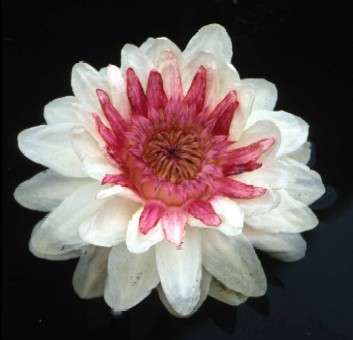Victoria cruziana
Victoria cruziana (Santa Cruz water lily, water platter, yrupe, synonym Victoria argentina Burmeist.) is a tropical species of flowering plant, of the Nymphaeaceae family of water lilies native to South America, primarily Bolívia, Argentina and Paraguay. The plant is a popular water garden plant in botanical gardens where its very large leaves can reach their fullest, up to 2 m wide with a thick rim up to 20 cm high.[1][2] It can be grown in cooler waters than its sister within the genus, the more familiar giant waterlily, Victoria amazonica.[3] A 25 cm diameter flower blooms for two days, arising from the underwater bud, as a white flower that turns to a deep pink on the second and final day of its bloom. V. cruziana is a thermogenetic or heat-producing plant. The plant prefers to live in colder non moving water and requires warm temperatures in order for the flower to blossom, hence the plant must distribute a lot of energy to keep itself warmer than its natural environment (above 90 degrees Fahrenheit).[4] The floral stigma are attached to a cup that is protected by spines, and the floral cup begins heating up in the bud, then, as the flower opens, it releases a strong sweet scent to attract pollinating beetles, then continues to provide heat to the flower while the beetles are pollinating.[3][5]
| Victoria cruziana | |
|---|---|
 | |
| Flower of Victoria cruziana | |
 | |
| Leaf of a Santa Cruz water lily (Victoria cruziana). Botanical Garden of Helsinki, Finland. | |
| Scientific classification | |
| Kingdom: | Plantae |
| Clade: | Tracheophytes |
| Clade: | Angiosperms |
| Order: | Nymphaeales |
| Family: | Nymphaeaceae |
| Genus: | Victoria |
| Species: | V. cruziana |
| Binomial name | |
| Victoria cruziana | |
Victoria cruziana was discovered in Bolivia on one of many expeditions through the country by Alcide d'Orbigny whose presence was sponsored by Andrés de Santa Cruz. The first collected specimens were returned to France where they were named in honor of Santa Cruz by Alcide's brother, Charles Henry Dessalines d'Orbigny.
References
- "Victoria cruziana (Santa Cruz waterlily)". Kew Gardens. Royal Botanic Gardens. Retrieved 24 November 2016.
- Nash, Helen; Steve Stroupe (2003). Complete guide to water garden plants. New York: Sterling Publishing. pp. 70–71. ISBN 1402709544.
- Lamprecht, I; E. Schmolz; S. Hilsberg; S. Schlegel (2002). "A tropical water lily with strong thermogenic behaviour— thermometric and thermographic investigations on Victoria cruziana". Thermochimica Act. 382: 199–210. doi:10.1016/s0040-6031(01)00734-1.
- Lamprecht, I., et al. “A Tropical Water Lily with Strong Thermogenic Behaviour—Thermometric and Thermographic Investigations on Victoria Cruziana.” Thermochimica Acta, vol. 382, no. 1-2, 2002, pp. 199–210., doi:10.1016/s0040-6031(01)00734-1. “Victoria Cruziana Orb.: Plants of the World Online: Kew Science.” Plants of the World Online, powo.science.kew.org/taxon/urn:lsid:ipni.org:names:605778-1. Wu, Q., et al. “Relationship between the Flavonoid Composition and Flower Colour Variation in Victoria.” Plant Biology, vol. 20, no. 4, 2018, pp. 674–681., doi:10.1111/plb.12835.
- Lamprecht, I; E. Schmolz; L. Blanco; C.M. Romero (2002). "Flower ovens: thermal investigations on heat producting plants". Thermochimica Acta. 391: 107–118. doi:10.1016/s0040-6031(02)00168-5.